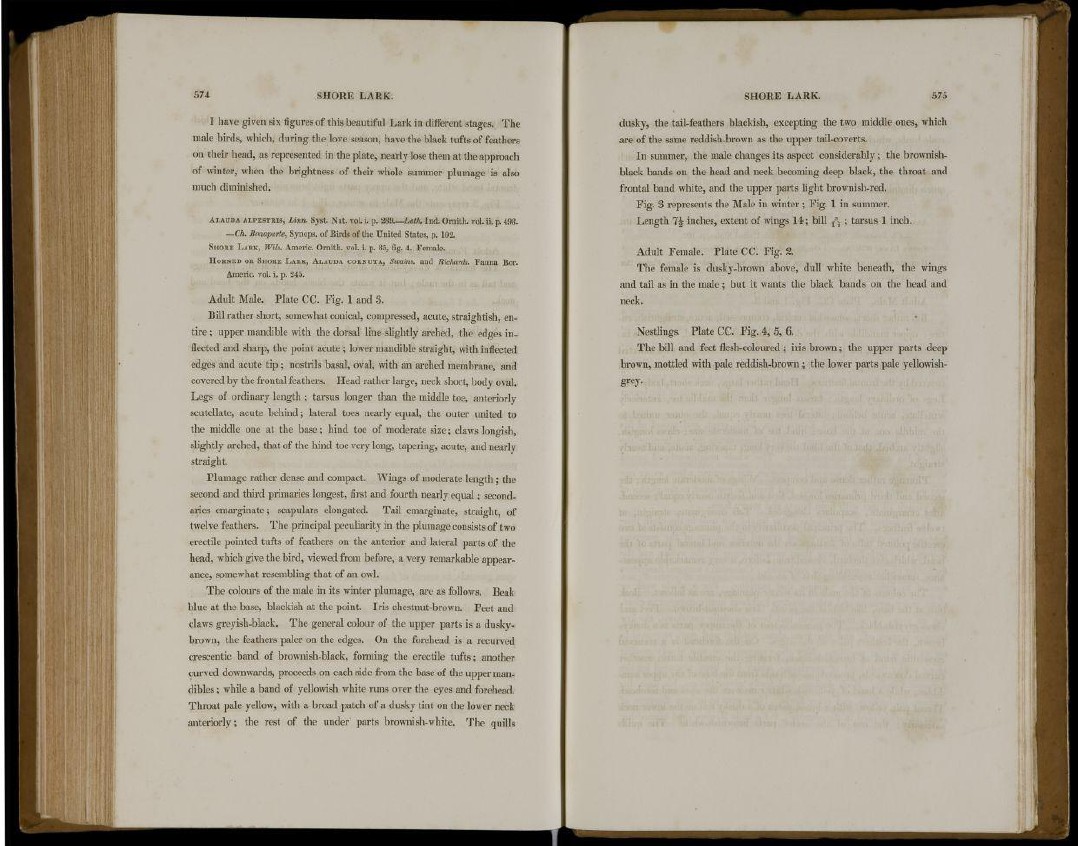
I have given six figures of this beautiful Lark in different stages. The
male birds, which, during the love season, have the black tufts of feathers
on their head, as represented in the plate, nearly lose them at the approach
of winter, when the brightness of their whole summer plumage is also
much diminished.
ALAUDA ALPESTRIS, Linn. Syst. Nat. vol. i. p. 289 Lath. Ind. Ornith. vol. ii. p. 498.
—Ch. Bonaparte, Synops. of Birds of the United States, p. 102.
SHORE LARK, Wits. Americ. Ornith. vol. i. p. 85, fig. 4. Female.
HORNED OR SHORE I .ARK, ALAUDA CORNUTA, Swains, and Bicliards. Fauna Bor.
Americ. vol. i. p. 245.
Adult Male. Plate CC. Fig. 1 and 3.
Bill rather short, somewhat conical, compressed, acute, straightish, entire
; upper mandible with the dorsal line slightly arched, the edges inflected
and sharp, the point acute ; lower mandible straight, with inflected
edges and acute tip ; nostrils basal, oval, with an arched membrane, and
covered by the frontal feathers. Head rather large, neck short, body oval.
Legs of ordinary length ; tarsus longer than the middle toe, anteriorly
scutellate, acute behind; lateral toes nearly equal, the outer united to
the middle one at the base; hind toe of moderate size; claws longish,
slightly arched, that of the hind toe very long, tapering, acute, and nearly
straight.
Plumage rather dense and compact. Wings of moderate length ; the
second and third primaries longest, first and fourth nearly equal; secondaries
emarginate; scapulars elongated. Tail emarginate, straight, of
twelve feathers. The principal peculiarity in the plumage consists of two
erectile pointed tufts of feathers on the anterior and lateral parts of the
head, which give the bird, viewed from before, a very remarkable appearance,
somewhat resembling that of an owl.
The colours of the male in its winter plumage, are as follows. Beak
blue at the base, blackish at the point. Iris chestnut-brown. Feet and
claws greyish-black. The general colour of the upper parts is a duskybrown,
the feathers paler on the edges. On the forehead is a recurved
crescentic band of brownish-black, forming the erectile tufts; another
curved downwards, proceeds on each side from the base of the upper mandibles
; while a band of yellowish white runs over the eyes and forehead.
Throat pale yellow, with a broad patch of a dusky tint on the lower neck
anteriorly; the rest of the under parts brownish-white. The quills
dusky, the tail-feathers blackish, excepting the two middle ones, which
are of the same reddish-brown as the upper tail-coverts.
In summer, the male changes its aspect considerably; the brownishblack
bands on the head and neck becoming deep black, the throat and
frontal band white, and the upper parts light brownish-red.
Fig. 3 represents the Male in winter; Fig. 1 in summer.
Length 7^ inches, extent of wings 14; bill f
5
3 ; tarsus 1 inch.
Adult Female. Plate CC. Fig. 2.
The female is dusky-brown above, dull white beneath, the wings
and tail as in the male; but it wants the black bands on the head and
neck.
Nestlings. Plate CC. Fig. 4, 5, 6.
The bill and feet flesh-coloured ; iris brown; the upper parts deep
brown, mottled with pale reddish-brown ; the lower parts pale yellowishgrey.